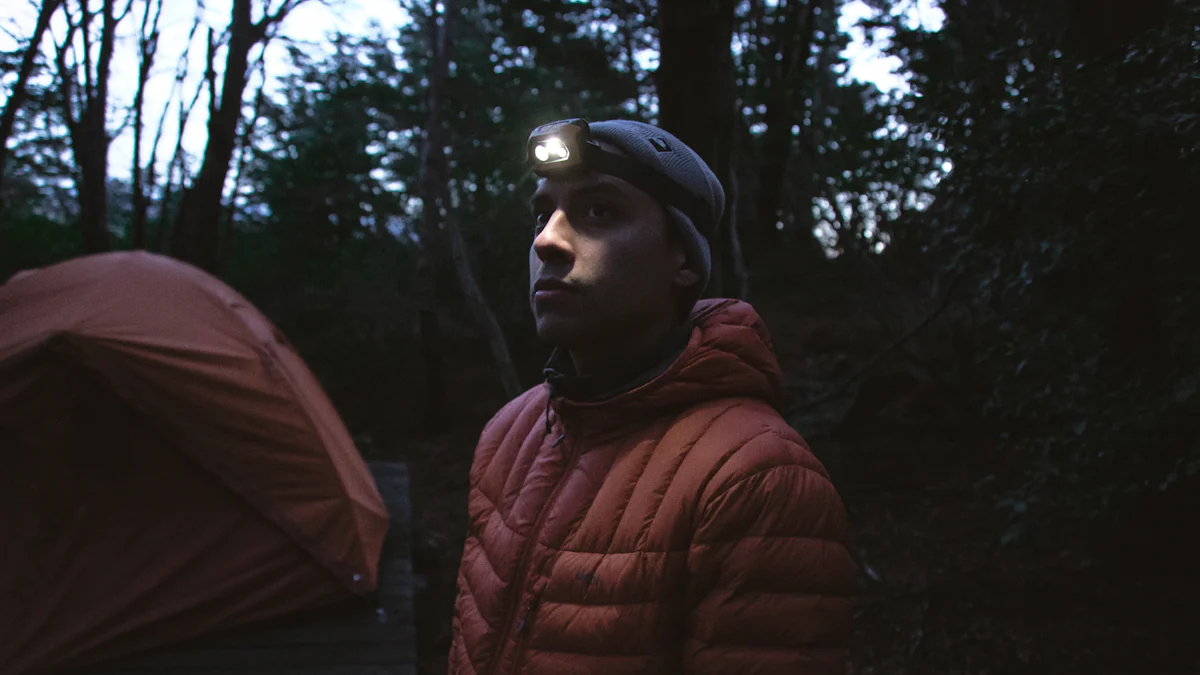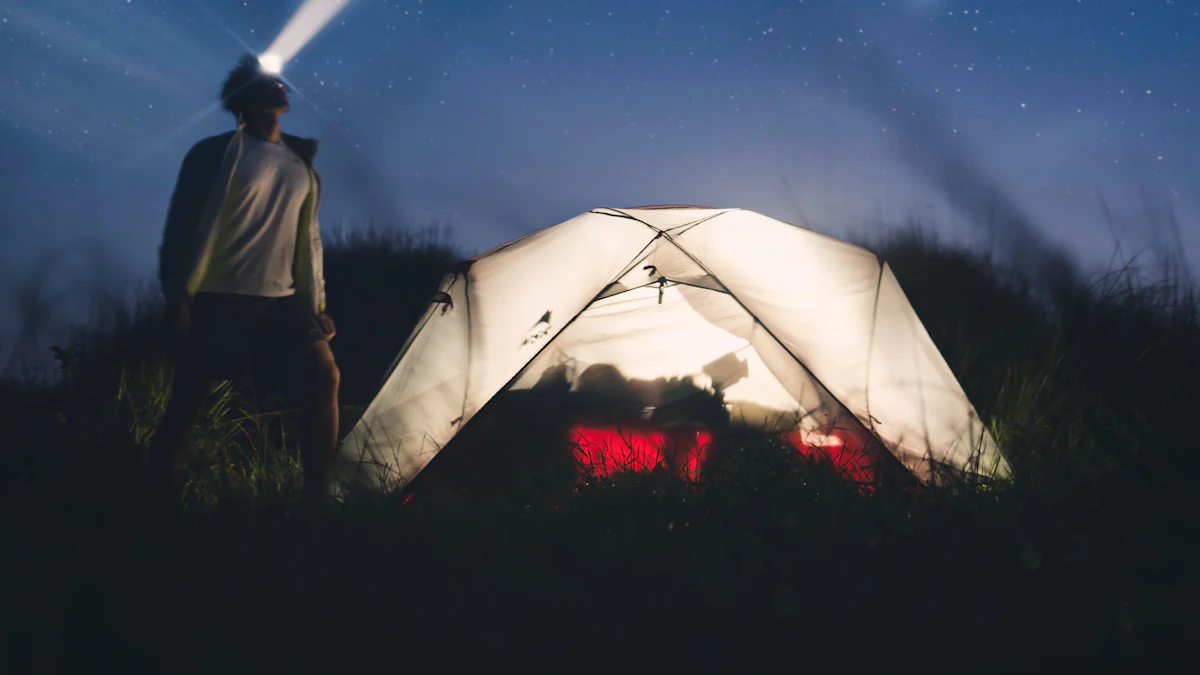Reliable Headlamps Are a Backpacker’s Best Friend

When you’re out in the wilderness, a reliable headlamp becomes your most trusted companion. It’s not just about lighting your way—it’s an essential tool for safety and convenience. Imagine navigating a rocky trail after sunset or setting up camp in the dark. A headlamp keeps your hands free, making these tasks easier and safer. Whether you’re hiking at night, dealing with unexpected delays, or simply cooking under the stars, this outdoor gear ensures you’re always prepared. With features like long battery life and red light settings, it’s a must-have for every backpacker.
Key Takeaways
A good headlamp keeps you safe by lighting dark paths. It helps you see and avoid things like rocks or roots.
You can use both hands to set up camp or cook. This is easier and safer than holding a flashlight.
Pick a headlamp with brightness you can change and different beams. This helps you have the right light for any situation.
Buy a strong headlamp with long battery life and weatherproofing. It will help you during delays or emergencies.
Clean your headlamp and check for damage often. This keeps it working well for all your outdoor trips.
Why a Reliable Headlamp is Essential for Backpackers

Safety and Navigation
Navigating trails after dark
When the sun sets, trails can quickly become tricky to navigate. A headlamp ensures you can see where you're going, even in complete darkness. With adjustable brightness levels, you can pick the right light intensity for your needs. Whether you're scanning the trail ahead or focusing on your feet, different beam patterns like spot and flood lighting make it easier to stay on course. Red light settings are another game-changer. They preserve your night vision, helping you avoid disorientation while hiking under the stars. Plus, a reliable headlamp works in all weather conditions, so you’re never left in the dark during a nighttime hike.
Avoiding hazards like roots, rocks, and wildlife
Roots, rocks, and unexpected wildlife can turn a peaceful hike into a dangerous situation. A headlamp helps you spot these hazards before they become a problem. With its ability to toggle between different lumen outputs, you can conserve battery life while still getting the visibility you need. Battery life indicators also let you monitor power levels, so you’re not caught off guard by sudden darkness. This kind of reliability keeps you safe and confident on the trail.
Hands-Free Convenience
Setting up camp or cooking in low light
Imagine trying to pitch a tent or cook dinner while holding a flashlight. It’s frustrating, right? A headlamp frees up your hands, making these tasks so much easier. You can focus on what you’re doing without juggling a light source. Whether you’re setting up camp or preparing a meal, hands-free lighting adds a level of convenience that’s hard to beat.
Performing tasks without holding a flashlight
From climbing to biking, having both hands free is essential. A headlamp stays securely on your head, providing consistent light wherever you look. This versatility makes it the best headlamp for backpacking and other outdoor adventures. You’ll appreciate how much easier it is to handle gear, navigate trails, or even read a map when you don’t have to hold a flashlight.
Emergency Preparedness
Handling unexpected delays or getting lost
Sometimes, things don’t go as planned. Maybe you underestimated how long a trail would take, or you wandered off the path. A headlamp ensures you’re prepared for these moments. Its long-lasting brightness helps you find your way back, even if you’re out longer than expected. With reliable illumination, you can stay calm and focused, even in challenging situations.
Signaling for help in emergencies
In an emergency, a headlamp can be a lifesaver. Many models come with strobe or SOS settings, which are perfect for signaling for help. Brightness levels and beam distance make it easier for rescuers to spot you, even from far away. When you’re in the wilderness, having a reliable headlamp could make all the difference.
Features of the Best Headlamp for Backpacking
Brightness and Beam Options
Understanding lumens and beam distance
When choosing a headlamp, brightness is one of the most important features to consider. Brightness is measured in lumens, which indicate how much light the headlamp produces. But how many lumens do you actually need? Here's a quick guide:
Lumen Range | Use Case |
|---|---|
10 lumens and under | Perfect for simple tasks like finding gear in your tent. |
80-150 lumens | Ideal for night hiking and general trail navigation. |
200-400 lumens | Great for spotting distant objects or searching the woods. |
Above 400 lumens | Overkill for most backpacking; better for extreme sports. |
For backpacking, a headlamp with 80-150 lumens usually offers the right balance of brightness and battery life.
Choosing between wide and focused beams
Beam options add versatility to your headlamp. Wide beams (flood) are great for close-range tasks like cooking or organizing your gear. Focused beams (spot) are better for long-distance visibility, like finding a trail marker in the dark.
Beam Type | Description | Usability |
|---|---|---|
Focused | A narrow, straight beam for illuminating distant points. | Perfect for hiking or spotting wildlife. |
Wide | A broad, diffuse light that covers a large area. | Best for campsite tasks or reading in your tent. |
Many headlamps let you switch between these modes, giving you the flexibility to adapt to different situations.
Battery Life and Power Sources
Rechargeable vs. disposable batteries
The type of battery your headlamp uses impacts its performance. Rechargeable batteries are eco-friendly and provide consistent brightness until they’re depleted. They’re great for multi-day trips if you have access to a power source. Disposable batteries, on the other hand, are easy to replace and last longer overall, but their brightness fades gradually.
Here’s a quick breakdown:
Rechargeable batteries: Reusable, stable light output, and better in cold weather. However, they require charging and can’t be used immediately if drained.
Disposable batteries: Widely available and reliable after long storage. But they create waste and lose charge faster in cold conditions.
Ensuring long-lasting power for multi-day trips
Battery life is crucial for extended backpacking trips. Popular headlamp models like the Black Diamond Spot 400-R can last up to 200 hours on their lowest setting. Always carry spare batteries or a power bank for rechargeable models. For cold weather, keep batteries warm by storing them close to your body.
Durability and Weather Resistance
Waterproof and impact-resistant designs
Backpacking gear needs to handle tough conditions, and your headlamp is no exception. Look for models with waterproof ratings like IPX4 (resistant to rain) or IP68 (can handle full immersion). Impact-resistant designs also ensure your headlamp survives accidental drops.
Materials suited for rugged conditions
Durable materials like reinforced plastic or aluminum make a headlamp more reliable. Models like the Fenix HM50R V2.0 are built to withstand extreme weather and rough handling. These features ensure your headlamp performs well, no matter where your adventure takes you.
Comfort and Adjustability
Lightweight designs for extended wear
When you’re out on the trail, every ounce of gear matters. A lightweight headlamp can make a big difference during long backpacking trips. You’ll barely notice it on your head, even after hours of wear. Many modern headlamps are designed with comfort in mind, using lightweight materials that reduce strain. This means you can focus on your adventure without feeling weighed down.
Ergonomic designs also play a key role in comfort. These headlamps are crafted to minimize pressure points, so you won’t feel discomfort even after extended use. Some models include padded headbands, which add an extra layer of cushioning. Whether you’re hiking, cooking, or setting up camp, a lightweight headlamp ensures you stay comfortable while enjoying consistent brightness.
Adjustable straps for a secure fit
A secure fit is just as important as comfort. Adjustable straps let you customize your headlamp to fit snugly, no matter your head size or shape. This prevents the headlamp from slipping or bouncing around while you move. You’ll appreciate this feature when you’re navigating uneven terrain or performing tasks that require precision.
Look for headlamps with straps that are easy to adjust on the go. Some models even include dual-strap systems for added stability. These designs keep the headlamp in place, so you can focus on your surroundings instead of constantly readjusting. Combined with lightweight materials, adjustable straps make your headlamp a reliable companion for any outdoor adventure.
Tip: For the best experience, choose a headlamp with both lightweight construction and adjustable straps. This combination ensures maximum comfort and functionality during your trip.
Best Headlamp Brands for Backpacking
Petzl: A Trusted Name in Outdoor Lighting
Features of the Petzl Actik Core
If you’re looking for a reliable and versatile headlamp, the Petzl Actik Core is a standout choice. It’s packed with features that make it perfect for backpacking. The intuitive control system lets you operate it effortlessly, even with gloves on. Its red light mode preserves your night vision and keeps you discreet when needed. The adjustable strap ensures a snug fit, so you can wear it comfortably for hours.
One of its best features is its dual power options. You can use the rechargeable Core battery for sustainability or switch to standard AAA batteries when you’re in remote areas. The Actik Core also boasts a phosphorescent reflector, making it easy to locate in the dark. With a focused spot beam and broad peripheral light, it offers excellent visibility for any outdoor activity.
Why Petzl is a favorite among backpackers
Petzl has earned its reputation by delivering dependable and innovative gear. The Actik Core’s brightness and reliability make it a staple for outdoor enthusiasts. Its single-button interface simplifies operation, while the rechargeable battery promotes eco-friendliness. Whether you’re navigating trails or setting up camp, Petzl’s headlamps are designed to perform in any situation.
Black Diamond: Innovation and Reliability
Overview of the Black Diamond Spot 400
The Black Diamond Spot 400 is another top contender for the best headlamp for backpacking. It’s lightweight, durable, and packed with features that make it a favorite among adventurers. With 400 lumens of brightness, it provides ample light for night hikes or campsite tasks.
Unique features that make Black Diamond stand out
Black Diamond’s innovations set it apart. The Spot 400 includes PowerTap technology, allowing you to adjust brightness with a simple tap. Its dual-fuel design gives you the flexibility to use either rechargeable or disposable batteries. The locking feature prevents accidental activation, saving battery life when it’s packed away.
You’ll also love its brightness memory, which remembers your last setting, so you don’t have to readjust every time you turn it on. The red light mode is perfect for preserving night vision, and the battery-life indicator helps you plan ahead. These features make the Spot 400 one of the best all-around headlamps for backpackers.
Other Noteworthy Brands
BioLite’s eco-friendly options
BioLite’s headlamps combine sustainability with cutting-edge technology. The HeadLamp 750 offers multiple light modes, including a brightness burst for tricky navigation. Its constant brightness feature ensures steady light until the battery is fully drained. Plus, the pass-through charging lets you use it while recharging, making it ideal for extended trips.
Fenix for high-performance lighting
Fenix headlamps, like the HM75R, are built for rugged adventures. They offer three types of light—spotlight, floodlight, and red light—giving you unmatched versatility. The Power Xtend System combines an external power bank with a standard battery for extended runtimes. With an IP68 rating, Fenix headlamps can handle harsh weather and tough conditions.
Tip: If you’re searching for the best budget headlamp, consider BioLite or Fenix. Both brands offer durable, feature-packed options that won’t break the bank.
Real-Life Benefits of a Reliable Headlamp

Personal Stories from Backpackers
How a headlamp prevented a hiker from getting lost
Picture this: you're hiking a scenic trail, and the sun sets faster than you expected. Suddenly, you're surrounded by darkness. This exact scenario happened to a backpacker who underestimated the time it would take to finish their hike. Thankfully, they had a reliable headlamp. Its bright beam illuminated the trail, helping them spot markers and avoid veering off course. The headlamp's versatility allowed them to switch between wide and focused beams, making navigation easier. Without it, they might have spent the night lost in the wilderness.
Using a headlamp to set up camp during a storm
Now imagine arriving at your campsite just as a storm rolls in. Rain pours, and the wind howls, making visibility almost impossible. One backpacker shared how their headlamp saved the day in this exact situation. With both hands free, they quickly pitched their tent and secured their gear. The headlamp's waterproof design and adjustable strap ensured it stayed in place, even in harsh conditions. This story highlights why having the best all-around headlamp can make or break your outdoor experience.
Lessons from Unreliable Gear
Risks of using cheap or poorly made headlamps
Using a low-quality headlamp might seem like a way to save money, but it often leads to frustration—or worse, danger. Imagine your headlamp dying in the middle of a hike because of poor battery life. Or worse, it breaks after a minor drop. Cheap models often lack essential features like weather resistance or adjustable brightness. These shortcomings can leave you stranded or struggling to complete basic tasks.
Why investing in quality gear is worth it
Investing in one of the best headlamps ensures you’re prepared for any situation. High-quality models offer durability, long battery life, and advanced features like red light modes or SOS signals. To avoid issues, always check your batteries before heading out. Use high-quality batteries, and plan your trip carefully. Arrive at the trailhead on time, and consider sunset times to avoid surprises. Reliable gear, like the best budget headlamp or even the best headlamp for running, is worth every penny when it keeps you safe and comfortable outdoors.
Tip: Always test your headlamp before your trip. A quick check can save you from unexpected failures when you’re miles away from help.
Practical Tips for Choosing and Using a Headlamp
Selecting the Right Batteries
Benefits of carrying spares or rechargeable packs
When you're out on the trail, having the right batteries can make or break your trip. Carrying spare batteries or a rechargeable pack ensures your headlamp stays powered when you need it most. Rechargeable batteries are perfect for shorter trips since they’re eco-friendly and easy to recharge. For longer adventures, standard AA or AAA batteries are a better choice because they last longer and are widely available.
Lithium batteries are another great option, especially if you're heading into cold conditions. They perform better in extreme temperatures and offer longer burn times compared to other types. To get the most out of your headlamp, choose one that works with lithium batteries and has an efficient power management system. This way, you’ll have reliable lighting for your entire journey.
Avoiding battery drain in cold weather
Cold weather can drain your batteries faster than you’d expect. To avoid this, keep spare batteries or your rechargeable pack warm by storing them close to your body. If your headlamp uses lithium batteries, you’re in luck—they handle cold temperatures much better than alkaline ones. Planning ahead and choosing the right batteries will help you maintain consistent brightness, even in freezing conditions.
Using a Mobile Phone as a Backup
When to rely on your phone’s flashlight
Your phone’s flashlight can be a handy backup if your headlamp fails. It’s great for quick tasks like finding something in your bag or checking a map. However, it’s not a replacement for a proper headlamp.
Limitations of phone lights compared to headlamps
Phone flashlights have several drawbacks. Their brightness is much lower, usually around 10-15 lumens, which isn’t enough for navigating trails or spotting hazards. Using your phone’s flashlight for extended periods also drains its battery quickly, leaving you without a communication device in emergencies. Plus, phones can overheat when used as a flashlight, especially in metal-bodied models. A headlamp is designed for outdoor use and offers better brightness, battery life, and durability.
Maintenance and Care
Cleaning and storing your headlamp properly
Taking care of your headlamp ensures it lasts for many adventures. After each trip, clean the lens with a soft cloth and mild soap to remove dirt and debris. Avoid abrasive cleaners that could scratch the surface. Store your headlamp in a dry, cool place to prevent moisture buildup, which can damage the internal components.
Checking for wear and tear before trips
Before heading out, inspect your headlamp for any signs of damage. Look for cracks, loose seals, or worn straps. These issues can compromise its performance, especially in wet or rugged conditions. Addressing small problems early will save you from unexpected failures on the trail. Regular maintenance keeps your headlamp reliable and ready for your next adventure.
Tip: Make a habit of checking your headlamp’s battery life and cleaning it after every trip. A little care goes a long way in keeping it in top shape.
A reliable headlamp is more than just a light source—it’s an essential tool that keeps you safe and prepared during outdoor adventures. Choosing the right headlamp means considering features like brightness levels, battery life, and comfort. Look for models with adjustable straps and weather resistance to ensure they perform well in any condition. High-quality headlamps, like the Black Diamond Spot 400-R, offer durability, better illumination, and long-term value. By investing in dependable gear, you’ll enhance your outdoor experience and tackle challenges with confidence.
Tip: Always balance weight, brightness, and battery options to find the perfect headlamp for your needs.
FAQ
What’s the ideal brightness for a backpacking headlamp?
For most backpacking trips, 80-150 lumens work well. This range provides enough light for hiking and campsite tasks without draining the battery too quickly. If you’re navigating tricky terrain or need long-distance visibility, consider a headlamp with up to 300 lumens.
Tip: Avoid overly bright headlamps (400+ lumens) unless you’re doing extreme activities.
How do I choose between rechargeable and disposable batteries?
Rechargeable batteries are eco-friendly and great for short trips. Disposable batteries last longer and are better for extended adventures. If you’re heading into cold weather, lithium batteries perform best.
Note: Carry spares or a power bank to avoid running out of power mid-trip.
Can I use my phone’s flashlight instead of a headlamp?
Your phone’s flashlight works in a pinch but isn’t a reliable substitute. It drains your phone’s battery quickly and doesn’t provide enough brightness for outdoor tasks. A headlamp offers better durability, hands-free convenience, and longer-lasting light.
How do I maintain my headlamp for long-term use?
Clean the lens with a soft cloth after every trip. Store it in a dry, cool place to prevent moisture damage. Check for cracks, worn straps, or weak seals before heading out. Regular maintenance keeps your headlamp reliable for years.
What’s the best way to avoid battery drain in cold weather?
Keep your batteries warm by storing them close to your body. Lithium batteries handle cold temperatures better than alkaline ones. Always carry spares to ensure you have light when you need it most.
Pro Tip: Use your headlamp’s lowest brightness setting to conserve power in freezing conditions.
See Also
Your Complete Guide to Choosing the Perfect Headlamp
Choosing Between Lanterns and Flashlights for Camping
Top Reddit Picks for Scuba Diving Headlamps Revealed
